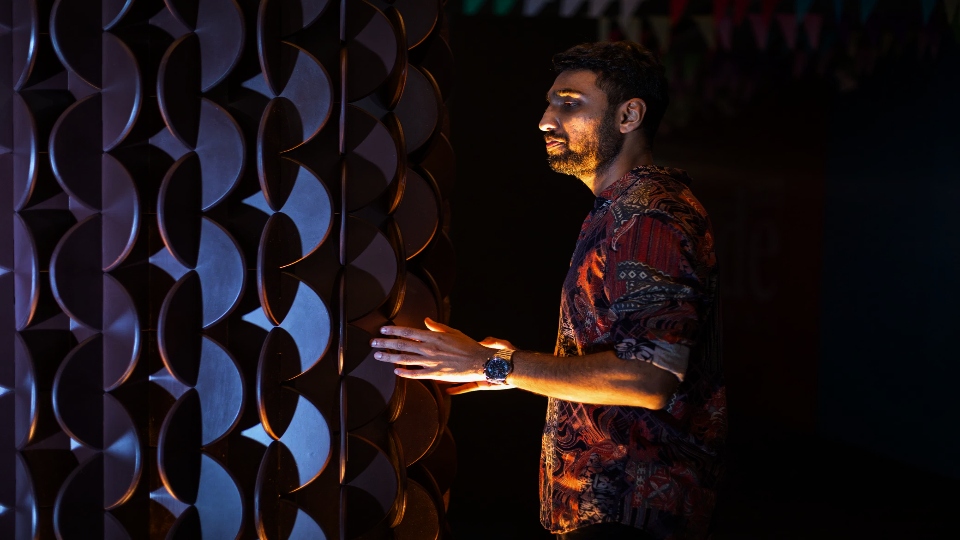Dubai Design Festival, the Middle East’s leading design platform bringing together creatives from the region and beyond, is back for its tenth edition. We’ve put together a retrospective of some of our favourite installations from this year’s programme, that represent the best in contemporary lighting design.

Already celebrated at Milan Design Week, this dynamic display enchants with its unique blend of light and sound.
This immersive experience transcends traditional lighting by harmonising dynamic illumination with rhythmic music. Each handblown crystal “pixel” responds to the beats, creating a mesmerising dance of lights. This symphony of sound and visual art invites visitors to engage both emotionally and intellectually, offering a multi-sensory journey that is both nostalgic and futuristic.
Inspired by early video game graphics, Crystal Beat employs Unreal Engine technology to create breathtaking 3D lighting scenes. The installation aims to evoke spontaneous emotions, merging the retro charm of digital beginnings with a contemporary expression that resonates with today’s tech-savvy audience. Each suspended crystal tube serves not only as a light source but also as a portal to another era, bridging the nostalgia of the past with modern technology.

Designed by emerging Saudi architects Abdulqader Alsuwaidan, Nawaf Alghamdi, Hayat Almousa and Lama Dardas, Iwan draws its inspiration from Islamic architecture, in particular ‘Iwan’, a distinctive transitional space, and ‘Muqarnas’, a form of ornamental decoration. Using geometric ornamentation and Islamic design principles, with an interplay of light and shadow, it reflects cultural history while utilising contemporary materials, celebrating architecture’s role in storytelling.

The Neo-Majlis by Future Bedouin merges traditional Bedouin culture with futuristic design, offering a soft pink inflatable pavilion inspired by the nomadic lifestyle. This contemporary twist on the classic majlis celebrates Middle Eastern heritage, creating a dreamlike space for connection and reflection. It symbolises resilience and adaptability, blending culture in a playful oasis.

Kristina Saakyan’s installation is inspired by the natural phenomenon of a “Mirage.” Comprising 300 meters of metal rods and 100 optical glass pieces of varying diameters, she transforms the optical effect into a visible experience from any angle when illuminated, blending the mirage into reality.
A mirage occurs when light bends as it passes through air layers of different temperatures, creating the illusion of water or reflective surfaces, especially in deserts or on hot roads. Unlike illusions, a mirage reflects real objects, but their appearance is altered—they may seem displaced, resized, or inverted due to the light’s refracted path.
Saakyan’s work invites individual interpretation offering a shifting, dynamic experience that reflects the complex behaviour of light.
Enfold: The Holistic Embrace of Body and Technology

This biomimicry-inspired installation features a dynamic 3D display of reflective wires, symbolising the harmony of body, mind, and technology through light and sustainable design.
Enfold embodies the holistic embrace of body and technology through biomimicry, with an exterior inspired by nature’s rough, spiky seeds and a soothing, regenerative core. Its circular geometry and continuous flow create a sense of enclosure, symbolising the unity between body, mind, and technology. Crafted from corrugated cardboard, the structure reinforces a sustainable ethos. The perforated roof allows natural light to filter through, shifting in intensity as the sun moves across the sky, emphasising the connection between light, space, and nature.

Coralis Lumina is inspired by coral reefs, merges marine beauty with environmental awareness. Using reused plastics and innovative 3D printing, it features organic forms and varying heights, illuminated from below to create a dynamic light-shadow experience. This installation highlights coral reefs’ essential role in biodiversity and their fragile state, symbolising resilience through its regenerative lighting. Coralis Lumina exemplifies how design can transform discarded materials into art, fostering awareness of environmental challenges and nature’s capacity for renewal.

Deep Jyoti Stambh is a kinetic sculpture by architect Ronak Hingarh, inspired by the Deepmalas—freestanding ornamental structures found outside traditional Hindu temples in southern India. This reimagining of the stambh draws from the ancient practice of lighting diyas (oil lamps) on Deepmalas to banish darkness and bring light to sacred spaces.
Crafted from modular pieces, the structure abstracts the intricate carvings of traditional Deepmalas, creating a seamless cylindrical form that preserves its ancient aesthetic while offering a modern experience through specially designed lighting. The rotating base, inspired by the Buddhist prayer wheel, invites the audience to spin the stambh, causing the lit surface to shift and creating a dynamic interplay of light and shadow.
Find out more about this year’s programme here.


